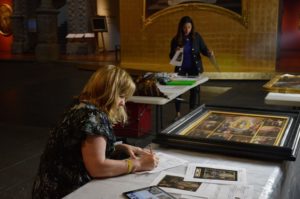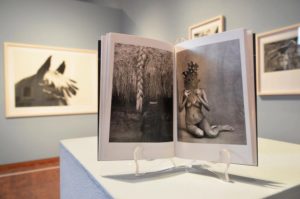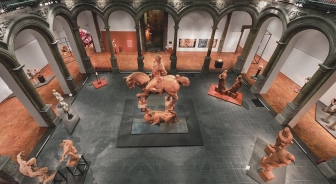Mexican art treasures to go on sale with the withdrawal of Citigroup
News Category: News, Community News, and General Discussion
-
A huge financial operation such as the one announced this week by Citigroup -closing its commercial banking operations and selling most of Banco Nacional de México, Banamex- will have enormous consequences for the financial system. But it will also have consequences for the art world.
For several decades, through the Fundación Fomento Cultural, Citibanamex has owned one of the most important Mexican art collections in the country, as well as several historic buildings that constitute cultural heritage. All this, iconic architectural venues and extensive art collection, will also be for sale with the exit of Citigroup. At a press conference on Thursday, the bank explained that it will not put the works and sites up for sale separately. In other words, the business group that decides to buy the bank’s branches, its family and business credit portfolio, its retirement fund administrator… must also commit to buying and preserving Citibanamex’s important cultural capital.
“It is an integral and indivisible part of what is for sale,” Alberto Gómez Alcalá, corporate director of Institutional Development, Economic Studies and Communication at Citibanamex, said insistently at a press conference. When asked, repeatedly, how much money he valued the bank’s entire cultural heritage, Gómez Alcalá reiterated that “it doesn’t matter the number in pesos and cents that we can give. We say that it is invaluable, that it is a hallmark of the [Citibanamex] brand, and we are sure that it will continue to be so”.

The valuable art collection includes works by Frida Kahlo, Remedios Varo and Leonora Carrington, and the muralists José Clemente Orozco, Diego Rivera and David Alfaro Siqueiros. There are around 2,000 pictorial works from the 18th to the 21st century, including oil paintings, watercolors and drawings, among others.
“An important aspect of the collection is its nationalist spirit,” art historian Angélica Velázquez Guadarrama, currently director of the Instituto de Investigaciones Estéticas, who has worked on exhibitions and catalogs of the collection, explains to EL PAÍS. She has also been an advisor to the Foundation for its acquisitions in the painting collection.
“More than 90% of the painting collection are Mexican artists or foreign artists who painted Mexican themes,” adds Velázquez Guadarrama. “It is the most important private painting collection in the country because it has always been characterized by buying works with Mexican themes: landscapes, customs, etcetera. They have works that you can’t find at the Munal [National Art Museum] or at Chapultepec Castle. If you want a complete panorama of Mexican painting since the viceregal era, in Mexico, you have to visit this collection”. Velázquez Guadarrama mentions, for example, the works in the collection of Eulalia Lucio, a Mexican artist from the 19th century that “you don’t find in any public collection”. Or the Sanromán sisters (Josefa and Juliana), precursors of Mexican painting in the 19th century, who are also in the collection.
Among other 20th century, works are Diego Rivera’s May Day Parade in Moscow (1956), Khalo’s The Fruits of the Earth (1938); or Siqueiros’ Woman with Metate (1931). Among the foreigners who have drawn Mexico are, for example, the Englishman Daniel Thomas Egerton and the German Johann Moritz Rugendas.

The Fundación Fomento Cultural has not only collected but also published dozens of catalogs and research on Mexican art, and has exhibited its works in temporary exhibitions at the Louvre in Paris, the Prado in Madrid, and the Metropolitan in New York. In Mexico, he also exhibits a good part of his collection free of charge at the iconic Palacio de Los Condes de San Mateo de Valparaíso, located in the historic center of the capital.
“Nobody relates other banks, such as Santander bank or Bancomer, with artistic heritage,” says Velázquez Guadarrama. “All banks have art collections, but making a catalog, making it known, opening a space so that everyone can contemplate it, are different policies” that Citibanamex does have.
This cultural heritage is also associated with its beautiful facilities, historical sites of baroque architecture in Mexico City and other parts of the country. The Foundation’s main headquarters is the Palacio de Iturbide, in the historic center of the capital, the former residence of independence icon Agustín de Iturbide. In addition, the Foundation owns the Casa Montejo Museum in the city of Mérida (Yucatán); the Palacio del Conde del Valle de Súchil in Durango; and the Casa del Mayorazgo de la Canal in San Miguel de Allende, Guanajuato.

“Another very important thing that Fomento Cultural Banamex has done is to give art status to the dissemination of popular art in Mexico,” says Kristina Velfu, an art consultant who currently works at an auction house and who has advised the Museo de Arte Popular on the photographic registration of its collection. “Mexico is the folk art capital of the world, and Banamex has a huge collection of great masters of folk art, which was handled elsewhere as crafts for many years. It was always underappreciated. This collection, on the other hand, shows its artistic, and even spiritual, value in Mexico.” In 1996, Banamex initiated a renowned Popular Art Support Program featuring works by Nahua, Otomi, Tzotzil, Mayan, and Mixtec artists, among others.
In addition to this, the bank has a giant documentary archive dating back to the Bank’s founding in 1884. It is the “most important financial archive in Mexico” for understanding the changes in the country’s economic sector over more than a century, said Gómez Alcalá, of Citibanamex, at the press conference.
The historical, artistic, and architectural collection, in fact, has been accumulating for more than a century, and so this is not the first time it has changed ownership. Twenty years ago, when Citigroup bought Banamex and therefore also its art collection, several Mexican artists publicly demanded that the cultural heritage should not end up in the United States, but stay in the country. “There was even false news that they were going to put a Burger Boy in one of the palaces,” recalls Velázquez Guadarrama. “They were absurd rumors, and none of that didn’t happen.”

The request was heard. The works stayed in Mexico, the collection was expanded, but now several experts in the art market are wondering what the price of the collection will be and how the INAH -National Institute of Anthropology and History- will seek to protect the bank’s architectural and artistic heritage. Many of its works (such as those by Rivera or María Izquierdo) are legally protected and cannot leave the country. But many others are not.
“In the history of the bank there have been several owners, and many times concerns and questions have arisen when there is a change of ownership,” said Gómez Alcalá, of Citibanamex, at the press conference. “The truth is that what we have seen is a constant: that commitment to culture on the part of Banco Nacional de México has been maintained. And it has been maintained because it is part of its essence, it is part of its DNA, it is part of its very definition, it cannot be distinguished. It is part of a whole that we cannot divide. Based on this history, we believe that the same thing will happen.
Now there is only one key element missing: to know who will be the buyer who will take, not only a good part of Banco de México but also the enormous responsibility of protecting its artistic heritage in Mexico.
-


Leave a Reply